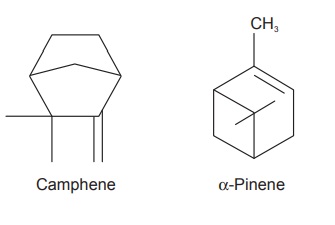Calamus
| Home | | Pharmacognosy |Chapter: Pharmacognosy and Phytochemistry : Drugs Containing Volatile Oils
Calamus consists of dried rhizomes of Acorus calamus Linn., belonging to family Araceae.
CALAMUS
Synonyms
Sweet Flag, Sweet cane, Sweet root, Sweet grass, Sweet rush.
Cinnamon sedge, Myrtle grass, Myrtle flag, Myrtle sedge, Sweet myrtle Beewort,
Calamus rhizome, Sweet segg
Biological Source
Calamus consists of dried rhizomes of Acorus calamus Linn., belonging to family Araceae.
Cultivation and Collection
The plants can be propagated by rhizomes either in early
spring or in late autumn. The portions of the rhizome are planted in damp,
muddy spots, on the margins of water. They are set 1 foot apart and
well-covered. It grows very well in moist ground which is rich and frequently
watered. The rhizomes are gathered generally after two or three years when they
are large enough. It is collected in late autumn or early spring.
Characterisitics
It is a semiaquatic perennial plant. The plant grows from 60
to 100 cm tall. The stem is triangular and sprouts from a horizontal, round
rootstock, which has the thickness of a thumb. The leaves are yellowish-green,
2 to 3 feet in length, oblong, sword-shaped, tapering into a long, acute point,
often undulate on the margins and arranged in two rows. The rhizome has an
intensely aromatic fragrance and a tangy, pungent and bitter taste. The flowers
are small dice-shaped, slim, conical spadix, greenish in colour appear from May
to July. Fruits are berries, full of mucus, which falls when ripe into the
water or to the ground. Rhizomes are about 20 cm long, 1 to 2 cm in diameter,
either peeled or unpeeled, reddish grey in colour, soft, porous, with
longitudinal furrows. On the lower surface there are small root scars which are
slightly raised.

Chemical Constituents
The dried rhizome contains about 1.5–2.7% of a neutral,
yellow, aromatic, essential oil. The fresh aerial parts yield about 0.12% of the
volatile oil, whereas the unpeeled roots yield the maximum of 1.5–3.5%. The
constituents present in calamus are acorin a volatile essential oil, amorphous,
which is semifluid, resinous, neutral in reaction, bitter and aromatic, and
soluble in alcohol, chloroform and ether; acoretin or choline is a bitter
principle with resinous nature; a crystalline alkaloid soluble in alcohol and
chloroform, Calamine; along with other constituents like bitter glucoside,
starch, mucilage and traces of tannin. The volatile oil is yellowish-brown in
colour and is composed of asaryl aldehyde, heptylic and palmitic acid, eugenol,
esters of acetic and palmitic acids, pinene, camphene, sesquiterpene, calamene
and a small quantity of phenol, methyl eugenol, cilamenenol, and calameone.

Uses
Calamus is an aromatic, bitter stomachic, carminative,
appe-tizer, digestive, spasmolytic, stomach tonic, nervine sedative, and
antiperiodic. The volatile oil is aromatic, expectorant and antiseptic, as a
flavouring agent, in perfumery. The dried root and rhizomes are chewed to
relieve dyspepsia, bronchitis and also chewed to clear the voice.
Marketed Products
It is one of the ingredients of the preparations known as
Abana, Mentat, Anxocare Pain massage oil (Himalaya Drug Company) and
Mahamarichadi tail, Brahma rasayan (Dabur).
